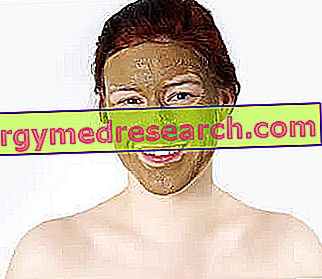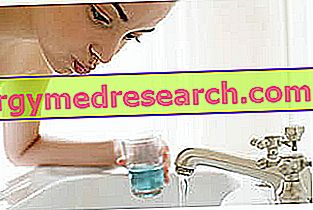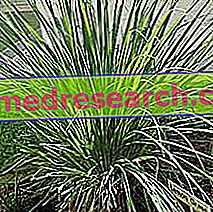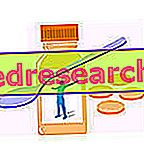Pimples is the term commonly used to indicate the cutaneous manifestation of acne. These are small red spots in relief (papules), often containing pus (pustules), which in severe cases of acne take on the characteristics of real nodules.
Their onset depends on an infectious inflammatory process that affects the pilosebaceous glands and hair follicles.

The most affected areas are the face, neck, chest and back.
The causes of pimples can be of various types: genetic, hormonal, infectious or psycho-emotional.
Other predisposing factors are: exposure to UV rays, chemical hypersensitivity to some products, the use of hormonal drugs, climate changes, etc.
When the pimples become too widespread and large, they are considered a disorder. Especially on the face, they can create dissatisfaction with one's image and important changes in social relations.
What to do
The measures to be taken to prevent the onset of pimples and reduce their severity are many and varied:
- Evaluate the metabolic impact of food and prefer those that do not cause the glycemic and insulinemic surge.
- Maximize the intake of vitamins, minerals and antioxidants of various kinds.
- Ensure a good state of hydration.
- Check for allergies (from contact, food, etc.).
- Use a light makeup and keep it on the skin as little time as possible.
- Prefer cosmetics that do not irritate the skin.
- Use mild detergents.
- Treat the skin of the face gently (for example during the drying phase).
- Avoid hormonal contraceptives.
- Use a medical prescription to begin specific drug therapy.
- Guarantee skin hygiene, possibly adopting products with function: anti-inflammatory, astringent, antibacterial and purifying.
- Pay close attention to hair removal; this concerns skin hygiene, method, post depilatory treatments (including the use of specific ointments) etc.
- Guarantee the intestinal function and the trophism of the bacterial flora.
- Ensure good liver health.
- In women, try to regularize the frequency of menstrual cycles.
- Exfoliate the skin with scrubs or dedicated chemical peels, turning to professionals and avoiding the "do it yourself"; for example:
- Physical exfoliants: salt, very fine powders obtained by shredding some seeds, rock alum or kaolin.
- Chemical exfoliants: alpha and beta-hydroxy acids, retinoids and polyhydroxy acids.
What NOT to do
- Abuse pasta, bread, pizza and sweets.
- Follow a monothematic diet, based mainly on preserved, cooked, dried and without fruit and vegetables.
- Fatigue the liver with unhealthy or excess foods, unnecessary supplements, sweet drinks, alcohol and unnecessary drugs.
- Consume foods obviously implicated in the onset of pimples (even if the cause is not known).
- Irritate the skin with excessively aggressive or cosmetic cleansers and creams based on: anolinis, isopropyl myristate, sodium lauryl sulfate and laureth-4.
- Exceed with makeup.
- Increase the fatness of the skin by applying greasy or oily products.
- Compromising skin hygiene by touching with dirty hands.
- Scratch, rub and crush pimples; this habit causes:
- Expansion of pathogenic bacteria on the rest of the face.
- Possible formation of definitive scars on the skin.
- Sun exposure during specific drug therapy for pimples.
- Application of retinoid-based products on mucous membranes or other delicate areas.
- Mix more drug therapies.
- To shave off or shave with old, not very sharp, dirty blades, without washing the skin before and after shaving.
What to eat
- Drink about one milliliter of water per calorie of food taken; an average person should take about two liters of water a day.
- Fresh fruits and vegetables, rich in antioxidant vitamins (carotenoids or pro-vitamin A, vitamin C, vitamin E) and polyphenols.
- Regarding the sources of carbohydrates, prefer foods with low or medium glycemic index and in adequate portions.
- Take a suitable amount of prebiotics (soluble fibers, carbohydrates not available, etc.) and probiotics (fermented foods such as yogurt, tempeh, kefir, tofu, etc.).
- Ensure the supply of zinc, especially in: liver, meat, milk and derivatives and some bivalve molluscs (especially oysters).
Some dietary supplements can be very useful.
What NOT to Eat
- Foods responsible for allergic reactions.
- Desserts, bread, pasta, pizza, potatoes, sweet and alcoholic drinks in excessive quantities.
- Avoid the consumption of "heavy" foods. The poor digestibility, above all linked to an excess of fats (sausages, fried foods, chocolate spreads etc.) seems to favor the appearance of pimples.
- Very salty foods.
Natural Cures and Remedies
Depending on the etiological cause of the pimples, one or more natural remedies can be used.
Some are:
- Purifying teas based on:
- Burdock ( Arctium lappa ).
- Dandelion ( Taraxacum officinale ).
- Pansy: diuretic, purifying and anti-acne action.
- Natural remedies to regularize the menstrual cycle (indicated when the pimples depend on certain hormonal alterations). They are indicated:
- Thyme ( Thymus vulgaris ).
- Calendula ( Calendula officinalis ).
- Fennel ( Foeniculum vulgare ): rich in flavonoids and phytoestrogens (normalizing female hormone levels and regularizing the menstrual cycle).
- Natural remedies to be taken orally (herbal teas / opercula) with a calming-anxiolytic action, indicated when pimples are triggered by excessive anxiety and stress:
- Chamomile ( Chamomilla recutita ).
- Valeriana ( Valeriana officinalis ).
- Lemon balm ( Melissa officinalis )
- Topical application of creams for pimples with purifying / remineralizing action:
- Clay (Bolus alba): enriches the skin with trace elements (silicon, iron, calcium, magnesium and aluminum) and purifies it from impurities (adsorbent properties).
- Wraps with essential oils with disinfectant action. It is necessary to dilute the essences in a little water and apply everything directly on the skin:
- Thyme ( Thymus vulgaris ).
- Lemon ( Citrus limon ).
- Sage (Salvia officinalis).
- Myrtle ( Myrtus communis ).
- Bergamot ( Citrus bergamia ).
- Topical application of natural antibacterial preparations:
- Melaleuca oil: natural remedy particularly indicated for refractory pimples.
- Immunostimulating teas:
- Echinacea ( Echinacea purpurea ).
- Natural liver detoxifiers, when pimples depend on liver fatigue:
- Boldo ( Peumus boldus ).
- Artichoke ( Cynara scolymus ).
- Milk thistle ( Silybum marianum ).
- Plant extracts with antiandrogenic properties:
- Serenoa repens.
- Pumpkin seeds.
- African pigeo ( Pygeum africanum ).
Pharmacological care
The pharmacological remedies for pimples are:
- Local application antibiotics: they are recommended for the treatment of serious and complicated pimples:
- Clindamycin (eg Dalacin-T cutaneous solution, Zindaclin gel).
- Metronidazole (eg Rozex cream / skin emulsion, Zidoval cream / gel)
- Antimicrobials:
- Benzoyl peroxide (eg Acnidazil, Benzac Clean).
- Azelaic acid (eg. Skinoren, Finacea).
- Hormonal treatment for women suffering from sudden changes in the levels of estrogen and progesterone that can cause pimples:
- Ethinyl estradiol and Cyproterone acetate (eg Diane, Dianette).
Prevention
- Eat properly, as we have specified in the dedicated paragraphs.
- Do not touch the face with dirty hands and wash them thoroughly, as well as the affected area, before makeup or hair removal (including shaving the beard).
- Also avoid contact with hair and items of doubtful hygienic condition (for example the motorcycle helmet never washed, etc.).
- Wash and possibly exfoliate the skin daily; professional deep cleansing treatments can help.
- If necessary, clean locally during the day with damp towels or mild disinfectants.
- Reduce global stress: sports, mental training and yoga can help.
Medical treatments
The alternative remedies for pimples are:
- Homeopathic treatments: Sulfur Iodatum, Calcium Bromatum and Natrum Muriaticum.
- Chemical exfoliating treatments: they have a keratolytic action, that is they compromise the intracellular junctions that bind the keratinocytes of the stratum corneum:
- Alpha hydroxy acids: lactic acid, mandelic acid, glycolic acid and tartaric acid.
- Beta-hydroxy acids: salicylic acid.
- Retinoids: retinoic acid and tretinoin.
- Polydroxyacids: lactobionic acid and gluconolactone.
- Laser therapy: remedy used to repair cicatricial lesions left by acne.



